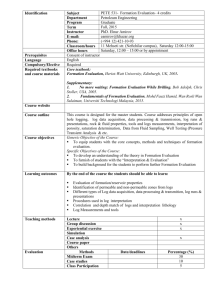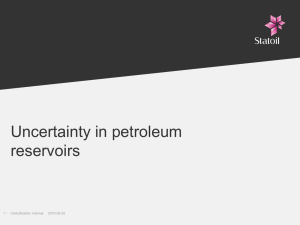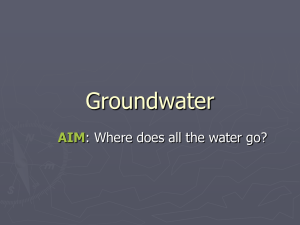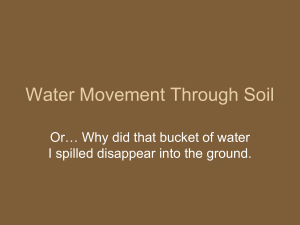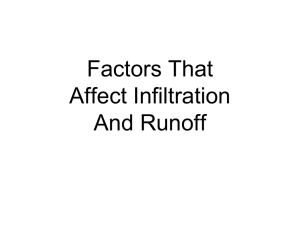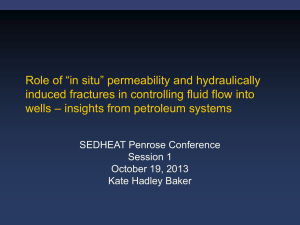Formation Evaluation
advertisement
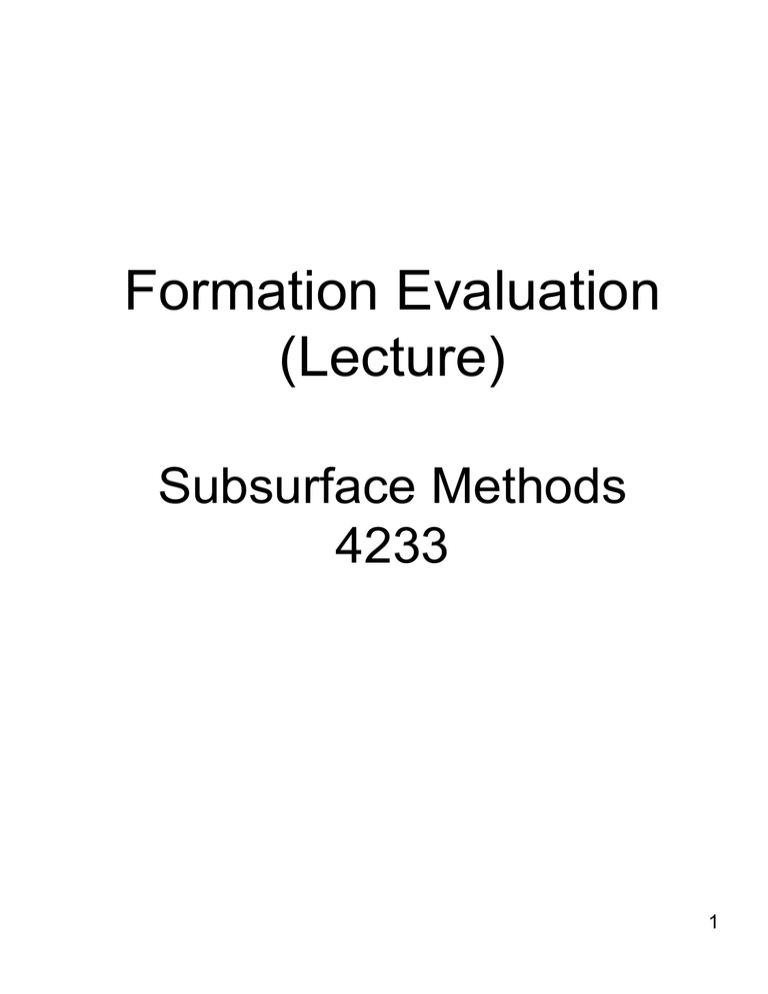
Formation Evaluation (Lecture) Subsurface Methods 4233 1 Porosity % Formation Density Log Determination of Porosity Ρb, Bulk Density g/cc 2 3 4 Typical hydrocarbon/water contact on resistivity log Ro 5 FORMATION EVALUATION FROM WELL LOGS Shaliness: Determined from Gamma-ray log. Not reliably interpreted from SP in impervious strata or in thin beds. Establish 0%, 50%, and 100% shale lines on the GR log. SS and LS intervals above the 50% cutoff are shaly. Rattiness of the GR log to the left or right of the 50% line indicates thin beds of SS & LS respectively. These beds are too thin for accurate log resolution but Are still very real! Shaly sands and carbonates (>40%) are generally worthless reservoirs despite their “apparent” porosity. Formation Factor (F) – needed for Sw calculation Ways to calculate F: F = Ro/Rw use only in clean, water-bearing formations having little clay or hydrocarbons. Formula has limited value or accuracy throughout an actual field or large area. Cannot be used when evaluating multiple reservoirs. Note: R0 = bed resistivity 100% water saturated and Rw = resistivity of formation water. F = a/Φm Archie equation or modification there-of (best) a = tortuosity constant dependent on rock texture (grain size, sorting, cementation, etc). Use 1 for carbonates and .81 for most sandstones in OK. m = cementation factor (1.4 to 1.7 slightly cemented; 1.8 to1.9 moderately cemented, 2.0 to 2.2 highly cemented). Use 2 for carbonates and sandstone in OK. Therefore: for sandstone use F = .81/Ø2 for limestone use F = 1/Ø2 6 Water/hydrocarbon saturation determination: Can be interpreted from: SP log – difficult, incorporates too many variables. All rock factors being equal, the SP is diminished in hydrocarbon -filled reservoirs as compared to when filled with water. Cores – often a bad choice since permeable rocks will be flushed during drilling thereby distorting values badly. Formula – Best, most accurate, and easy to use in all rock types and saturation conditions. Uses “hard” numbers instead of guesses and extrapolated values. Sw = solving for Rw: FRw Rt Rw = Sw2Rt F Using this method, find a nearby well (usually low to production) that has good reservoir characteristics but is decidedly wet. This zone will have the lowest resistivity for the particular reservoir of interest and will obviously be dry. It can safely and accurately be assumed that Sw in this interval is between 95%-100% and obviously, even an error of a few % will not result in large error in calculation of Rw. From the same well and zone, Rt and F can accurately be determined from well logs to calculate Rw. Then, use the SW formula (above) with the calculated Rw to determine hydrocarbon saturation in the same reservoir throughout the field. 7 Determining water/hydrocarbon saturation, continued Alternatively, find an interval of the same rock type stratigraphically close to the reservoir of interest that has unusually low resistivity compared to know pay zones in the field area. These zones may have residual hydrocarbons but the presumed water saturation is still high and probably in the range of 85-90% (or higher). Using this presumed water saturation, back-calculate Rw and then use the Sw formula to determine water/hydrocarbon saturations. Another useful formula but of limited value is below: Sw = Ro Rt Its use should be limited to beds having similar reservoir characteristics (texture, sorting, cementation, porosity), and similar formation water salinity. These conditions obviously do not often occur in nature so the formula is appropriate only for a thick, relatively homogenous reservoir having oil saturation above a water column. 8 Porosity Determination: In gas-filled reservoirs: use standard density and neutron cross-plot values when available. Splitting the difference between the two log traces will yield sufficiently accurate values in LS strata. In sandstone reservoirs the cross plot porosity may have to be reduced a few porosity units to mimic true porosity as determined from core data. In oil reservoirs: there will be little or no density-neutron porosity cross over. If the reservoir is clean (little shale/clay, you probably can proceed as described above. If there is appreciable clay/shale (as determined by the GR log) I would ignore the neutron porosity and rely solely upon density values since they are not nearly as affected by clay. If necessary, reduce the density porosity a few units to match expected core data. Remember that porosity logs are usually calibrated to a limestone matrix. Therefore, theoretical porosity in sandstone may be too high on both the density and neutron logs and too low in dolomite. Porosity values are also influenced by matrix material between grains, cementation, pore fluids, among other things. Log corrections are NOT done by the service companies nor represented on the log. YOU must do it if necessary. Locally, no corrections are necessary when core porosity mimics log porosity. If not, you may need to subtract 2-3 porosity units from that recorded on the density log in sandstone strata. Gas seriously affect values on all porosity logs. If you have only one log, say density porosity, you must decrease its value appropriately to diminish this gas effect. This can be done by documenting the gas effect in other wells having both density & neutron log suites. The cross plot porosity in the later will indicate how many porosity units are causing the gas effect and a ratio (usually ~.65 to .7) can be applied to the well having only Density porosity. 9 Personally, I would not want to use strictly neutron porosity because of its sensitivities to both clay and formation gas. Detecting a Depleted Gas Reservoir When cross-plot porosity exceeds 10-12 porosity units, pressure depletion can be presumed GR & SP 30 % Porosity 20 10 0 8-10 porosity units separation = normal pressured reservoir (gas effect) 14-16 porosity units of separation = pressure depletion! 10 Determination of Permeability (K) 1. From cores – usually the best method but cores are few and farbetween! Permeability measurements are expressed in millidarcys - md (one thousandth of a darcy). It is affected by many formation attributes such as pressure, rock texture, and fluid content. For convenience, It is measured in the lab by passing inert gas such as helium or nitrogen through samples. The resulting flow is converted to values relevant to common air (KA). Because this data is often unrealistic, it is frequently converted into units that more accurately relate to liquid permeability (pure water). Note that the viscosity of water is similar to that of many oils. This “liquid” permeability is then called “Klinkenberg” permeability or KK. KA is generally quite inaccurate in tight reservoirs but closely approximates KK in reservoirs having > a few hundred md. 2. Pressure decline testing (cannot do on a well-by-well basis or for multiple reservoirs) conveniently. 3. Porosity vs. Permeability Plot. Very good – see examples provided. Need to get only one or two cores in the nearby area having reliable density-neutron log suites. You can then input any porosity value into the plot to get a good value of permeability. 4. Interpreted quantitatively from micrologs, conventional resistivity logs (noting separation between the shallow and deep measurements), and from the caliper log (which measures mudcake buildup that is a function of permeability). 5. From porosity and Swi (irreducible water saturation) This method is not easy to complete accurately using standard log suites. Swi is very, very sensitive to porosity, reservoir texture, oil viscosity, and just having a bad day in the office! I personally have not used it successfully and do not recommend its use. 6. From SP logs. A very good qualitative method of estimating reservoir permeability. Limitations include bed thickness, fluid 11 content, and resistive bounding strata. Porosity vs. Permeability Plots from core. This is perhaps the best way to determine permeability in the same formation in nearby wells having a reliable porosity suite 12 13 Common normal subsurface pressure gradient Overpressured ppg = pounds per gallon pcf = pounds per cubic ft 14 15
